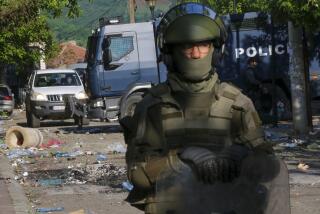Isolated Krajina Serbs Could Be Bested by Resurgent Croat Army : Balkans: Rebels can’t rely on help from federal Yugoslav military, which helped carve out their now-threatened enclave.
ZAGREB, Croatia — If the rekindled battle over Croatia’s Krajina region continues to escalate, the Serbian militants who have been flexing their armed muscle there for the past two years may be in for a brutal comeuppance.
Krajina’s rebel Serbs seized their desolate enclave from Croatia in 1991 thanks to the tanks and guns of the Yugoslav federal army, which these days is nowhere to be seen in the dangerous neighborhood.
The rebels’ heavy weapons were spirited away to Bosnia-Herzegovina last spring to escape impoundment under a U.N. peacekeeping accord. The hardware is now employed by the Bosnian Serbs in fighting in that republic and is unlikely to be returned to the area.
The Krajina, which means frontier and was a military buffer zone for the Austro-Hungarian Empire, is an arc of largely Serb-inhabited Croatian territory along the northwest Bosnian border.
Stretched thin across hundreds of miles of land captured by the federal forces, Krajina Serbs also face a Croatian government army that is better-armed and better-organized than when the rivals clashed after Croatia declared independence in 1991.
Military and diplomatic sources say Zagreb has spent the past year acquiring weapons and training its soldiers, while Serbian nationalists in Belgrade have shut off the supply lines to Krajina, leaving their brother Serbs dependent on foreign aid and encircled by an angry enemy.
“We are not the same army they faced in the first war,” said a Croatian Defense Ministry official who spoke on condition he not be named. “Now we are organized and have more weapons and they (Krajina Serbs) can no longer count on Belgrade to fight for them.”
Since last spring, when a U.N.-brokered cease-fire imposed a tense peace in Croatia, the government has managed to strengthen its forces despite an arms embargo supposedly covering all of the former Yugoslav republics.
Croatia has spent $250 million on black-market weapons over the past 15 months, stockpiling more than 1,000 shoulder-launched antiaircraft missiles as well as first-rate antitank equipment, said Paul Beaver, publisher of the authoritative Jane’s Defence Weekly of Britain.
Zagreb also has 120 tanks--many captured from the federal army during the 1991 battles--and it has bought uniforms, ration packs and communications equipment from an array of European and American sources, Beaver said.
Conversely, the rebel Serbs either turned their tanks and artillery pieces over to U.N. peacekeepers for monitoring, as required by the cease-fire, or packed them off to Bosnia to avoid giving them up.
When Croatian government troops launched a major offensive in the Serb-occupied Krajina on Jan. 22, the rebels broke into the U.N.-monitored warehouses and stole back what armor they could.
Lt. Gen. Satish Nambiar, the commander of the U.N. protection force in Croatia and Bosnia, said Serbian rebels recovered heavy weapons from a large number of depots in the U.N.-patrolled areas and presumably have redeployed them.
But he noted that much of the recaptured hardware had not been maintained for months and lacked fuel and ammunition.
Croatian forces broke the year-old cease-fire after losing patience with a U.N. peacekeeping plan that froze the status quo of rebel control over the vast lands seized from Croatia in 1991. About one-third of the republic was lost to the rebels, who have systematically expelled non-Serbs and severed transportation and communication links between Zagreb and the Adriatic Sea coast.
Since the offensive began, the Zagreb government has regained control of a strategic bridge linking the republic’s interior with vital Adriatic ports and resorts. The Croatian army also has retaken Zemunik Airport and the huge Peruca hydroelectric complex, although the latter was seriously damaged by retreating Serbian fighters Thursday.
Fighting has flared across an 80-mile arc inland from the port of Zadar, chasing the Serbian rebels back toward their political base in Knin.
On Saturday, Knin officials offered to abide by a truce while repairs to the leaking Peruca Dam are conducted, another sign that they may be aware of their newfound vulnerability.
It remains to be seen whether Croatian President Franjo Tudjman will now halt what he has insisted is a “limited operation.”
Western diplomats here believe Tudjman ordered the offensive to demonstrate that he would not indefinitely tolerate U.N. failure to end Serbian occupation of his country.
“The Croats took a calculated risk, feeling they had right on their side, though one might say they’ve shot themselves in the foot by drawing opposition from the international community,” said one Zagreb-based envoy, referring to U.N. condemnation of Croatia’s aggression. “There were a lot of valid reasons for recapturing that bridge--domestic political concerns, economic development, rejoining the interior with an area where 700,000 Croats live.”
Some observers believe the Zagreb leadership will escape with nothing more than the diplomatic hand slap already issued if no further incursions into U.N.-patrolled territory are attempted.
“Croatia will use this action as a stick,” said another diplomatic source. “When negotiating with Zagreb, the Serbs will have this in mind. Call it a balance of fear.”
But predictions of quick containment of the crisis are undermined by waning hopes of a negotiated solution to the war in neighboring Bosnia, by the Krajina Serbs’ propensity for defiance despite daunting odds and by an across-the-board breakdown of U.N. authority in the region.
Violent clashes among Muslim Slavs, Serbs and Croats in Bosnia have escalated out of control, endangering--as does the Krajina offensive--the U.N. troops deployed among hostile forces without a mandate to impede the belligerents’ fighting. The peacekeepers are authorized to use their weapons only when fired upon.
Should the United Nations withdraw its forces, as Secretary General Boutros Boutros-Ghali has threatened, Krajina Serbs would be extremely vulnerable without the backup of the Belgrade-based Yugoslav army.
“The logistics line is too long between Belgrade and Knin,” said a Croatian military analyst, referring to the hundreds of miles of volatile territory Yugoslav forces would have to cross to get arms, ammunition and fuel to Krajina brethren for an effective defense.
Serbian strongman Slobodan Milosevic, Yugoslav President Dobrica Cosic and other nationalist leaders in Belgrade who have directed the nearly 2-year-old chain of rebellions in Croatia and Bosnia are believed to have overextended their armed forces in the process. Serbs in northeastern Bosnia have been dealt severe setbacks by strengthened Bosnian government forces in recent weeks, and the Croatian offensive inland from Zadar has exposed weakness in the Krajina defense.
Belgrade could unleash its considerable arsenal of warplanes to back up the overcommitted ground troops in Bosnia or Croatia, but such a blatant use of air superiority would probably bring Western intervention.
Analysts say that as long as the fighting does not spill into Serbia proper, Belgrade is unlikely to take on the strengthened Croatian army on behalf of the distant and economically draining Krajina enclave.
Cosic confirmed during a visit to Greece last week that the federal army had no plans to intervene and would leave it to U.N. forces to protect Serbs in the Krajina.
Gen. Radovan Radinovic, the Yugoslav army’s chief of defense policy, said he saw no need for federal intervention for the time being.
“They are doing quite well there. They are defending their homes, their territory where they have been for centuries,” the general said of the Croatian Serbs. “I personally hope the army will not have to intervene. What the threshold of tolerance is, is difficult to say, but if the very survival of the Serbs there was in jeopardy then probably that is the threshold.”
Special correspondent Laura Silber, in Belgrade, contributed to this article.
More to Read
Sign up for Essential California
The most important California stories and recommendations in your inbox every morning.
You may occasionally receive promotional content from the Los Angeles Times.











